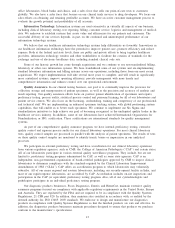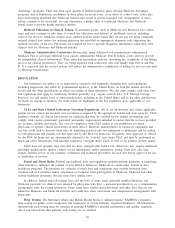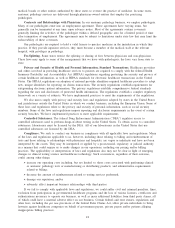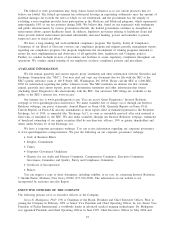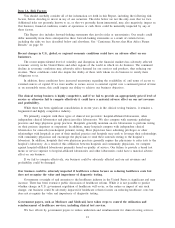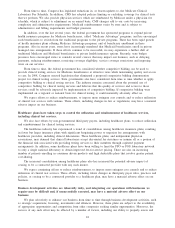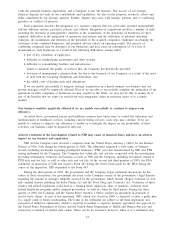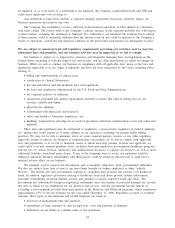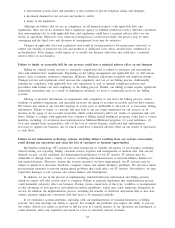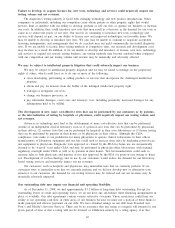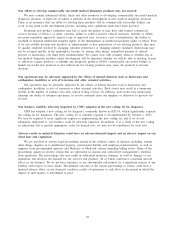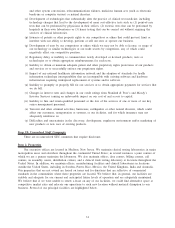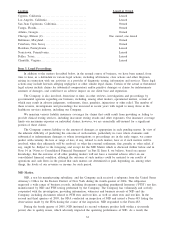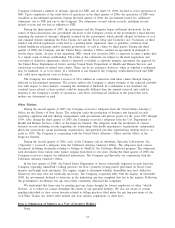Quest Diagnostics 2008 Annual Report Download - page 35
Download and view the complete annual report
Please find page 35 of the 2008 Quest Diagnostics annual report below. You can navigate through the pages in the report by either clicking on the pages listed below, or by using the keyword search tool below to find specific information within the annual report.value the potential business opportunity, and to integrate it into our business. The success of our strategic
alliances depends not only on our contributions and capabilities, but also on the property, resources, efforts and
skills contributed by our strategic partners. Further, disputes may arise with strategic partners, due to conflicting
priorities or conflicts of interests.
Each acquisition involves the integration of a separate company that was previously operated independently
and has different systems, processes, policies and cultures. Integration of acquisitions involves a number of risks
including the diversion of management’s attention to the assimilation of the operations of businesses we have
acquired, difficulties in the integration of operations and systems and the realization of potential operating
synergies, the assimilation and retention of the personnel of the acquired companies, challenges in retaining the
customers of the combined businesses, and potential adverse effects on operating results. The process of
combining companies may be disruptive to our businesses and may cause an interruption of, or a loss of
momentum in, such businesses as a result of the following difficulties, among others:
•loss of key customers or employees;
•difficulty in standardizing information and other systems;
•difficulty in consolidating facilities and infrastructure;
failure to maintain the quality of services that our Company has historically provided;
•diversion of management’s attention from the day-to-day business of our Company as a result of the need
to deal with the foregoing disruptions and difficulties; and
•the added costs of dealing with such disruptions.
If we are unable successfully to integrate strategic acquisitions in a timely manner, our business and our
growth strategies could be negatively affected. Even if we are able to successfully complete the integration of the
operations of other companies or businesses we may acquire in the future, we may not be able to realize all or
any of the benefits that we expect to result from such integration, either in monetary terms or in a timely
manner.
Our business could be negatively affected if we are unable successfully to continue to improve our
efficiency.
As noted above, government payers and healthcare insurers have taken steps to control the utilization and
reimbursement of healthcare services, including clinical testing services; such steps may continue. If we are
unable to continue to improve our efficiency to enable us to mitigate the impact on our profitability of these
activities, our business could be negatively affected.
Adverse resolution of the investigation related to NID may cause us material losses and have an adverse
impact on our business and reputation.
NID and the Company each received a subpoena from the United States Attorney’s Office for the Eastern
District of New York during the fourth quarter of 2004. The subpoenas requested a wide range of business
records, including documents regarding parathyroid hormone (“PTH”) test kits manufactured by NID and PTH
testing performed by the Company. The Company has voluntarily and actively cooperated with the investigation,
providing information, witnesses and business records of NID and the Company, including documents related to
PTH tests and test kits, as well as other tests and test kits. In the second and third quarters of 2005, the FDA
conducted an inspection of NID and issued a Form 483 listing the observations made by the FDA during the
course of the inspection. NID responded to the Form 483.
During the third quarter of 2007, the government and the Company began settlement discussions. In the
course of those discussions, the government disclosed to the Company certain of the government’s legal theories
regarding the amount of damages allegedly incurred by the government, which include alleged violations of civil
and criminal statutes including the False Claims Act and the Food, Drug and Cosmetics Act. Violations of these
statutes and related regulations could lead to a warning letter, injunction, fines or penalties, exclusion from
federal healthcare programs and/or criminal prosecution, as well as claims by third parties. During the third
quarter of 2008, the Company and the United States Attorney’s Office reached an agreement in principle to
resolve these claims. As part of the agreement, NID, which was closed in 2006, is expected to enter a guilty plea
to a single count of felony misbranding. The terms of the settlement are subject to the final negotiation and
execution of definitive agreements, which is expected to include a corporate integrity agreement, the approval by
the United States Department of Justice and the United States Department of Health and Human Services and
satisfactory resolution of related state claims. There can be no assurance, however, when or if a settlement may
23


